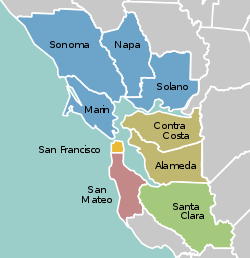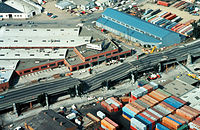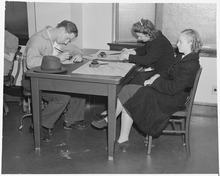Portal:San Francisco Bay Area
The San Francisco Bay Area Portal  The San Francisco Bay Area (referred to locally as the Bay Area) is a populous region surrounding the San Francisco and San Pablo estuaries in Northern California. The region encompasses the major cities and metropolitan areas of San Jose, San Francisco, and Oakland, along with smaller urban and rural areas. The Bay Area's nine counties are Alameda, Contra Costa, Marin, Napa, San Francisco, San Mateo, Santa Clara, Solano, and Sonoma. Home to approximately 7.68 million people, the nine-county Bay Area contains many cities, towns, airports, and associated regional, state, and national parks, connected by a network of roads, highways, railroads, bridges, tunnels, and commuter rail. The combined statistical area of the region is the second-largest in California (after the Greater Los Angeles area), the fifth-largest in the United States, and the 43rd-largest urban area in the world with 8.80 million people. The Bay Area has the second-most Fortune 500 companies in the United States, after the New York metropolitan area, and is known for its natural beauty, liberal politics, entrepreneurship, and diversity. The area ranks second in highest density of college graduates, after the Washington, D.C. metropolitan area and performs above the state median household income in the 2010 census; it includes the five highest California counties by per capita income and two of the top 25 wealthiest counties in the United States. Based on a 2013 population report from the California Department of Finance, the Bay Area is the only region in California where the rate of people migrating in from other areas in the United States is greater than the rate of those leaving the region, led by Alameda and Contra Costa counties. (more...) Selected article The earthquake occurred during the warm-up practice for the third game of the 1989 World Series, featuring both of the Bay Area's Major League Baseball teams, the Oakland Athletics and the San Francisco Giants. Because of game-related sports coverage, this was the first major earthquake in the United States to have its initial jolt broadcast live on television. (more...) Selected biography Seaborg spent most of his career as an educator and research scientist at the University of California, Berkeley, serving as a professor, and, between 1958 and 1961, as the university's second chancellor. He advised ten US Presidents – from Harry S. Truman to Bill Clinton – on nuclear policy and was Chairman of the United States Atomic Energy Commission from 1961 to 1971, where he pushed for commercial nuclear energy and the peaceful applications of nuclear science. Throughout his career, Seaborg worked for arms control. He was a signatory to the Franck Report and contributed to the Limited Test Ban Treaty, the Nuclear Non-Proliferation Treaty and the Comprehensive Test Ban Treaty. He was a well-known advocate of science education and federal funding for pure research. Toward the end of the Eisenhower administration, he was the principal author of the Seaborg Report on academic science, and, as a member of President Ronald Reagan's National Commission on Excellence in Education, he was a key contributor to its 1983 report "A Nation at Risk". (more...) Selected city Selected image
The Bay Area by year1909
  • The first Portola Road Race (pictured, left) is run through Melrose in Oakland, San Leandro and Hayward, with at least 250,000 attending Selected historical image Alvord Lake Bridge, Golden Gate Park, the first reinforced concrete bridge in the United States. (1984) image credit: Historic American Engineering Record
Did you know...
Previous Did you know... 
Selected periodic event The San Francisco Marathon is a series of USATF certified road running events held each June, July or August in San Francisco that include a full marathon, two half marathons, and a 5K. Except for in 1988, the marathon has been held annually since 1977. The current marathon course forms a loop that starts and finishes on the Embarcadero near the Ferry Building. The course runs past many notable landmarks in San Francisco including Fisherman's Wharf, Aquatic Park, the Golden Gate Bridge, Golden Gate Park, and AT&T Park. (2009 host Dean Karnazes, at the 2008 Napa Valley Marathon, pictured) Quote
Selected multimedia file
Scheherazade', Opus 35, first movement, Rimsky-Korsakov, as performed by the San Francisco Symphony Orchestra conducted by Pierre Monteux credit: San Francisco Symphony Orchestra
Bay Area regions, geographic features and protected areasRelated PortalsWikiProject
Things you can do *Write an article on a Bay Area-related subject Selected panoramaSan Francisco Bay Area categoriesBay Area | San Francisco Bay | San Francisco | San Jose | Oakland | Cities | Census-designated places | Historic Places | National Landmarks | Counties: Alameda | Contra Costa | Marin | Napa | San Mateo | Santa Clara | Solano | Sonoma
Architecture | Attractions | Books | Culture | Economy | Education | Environment | Events & Festivals | Geography | Government | History | Landmarks | Law | Mass media | Military | Music | Organizations | Parks | People | Politics | Science | Sports | Transport
Full category tree
Select [►] to view the full category tree.
Associated WikimediaThe following Wikimedia Foundation sister projects provide more on this subject:
Discover Wikipedia using portals |
- Manually maintained portal pages from November 2019
- All manually maintained portal pages
- Portals that need updating
- Portals with minor issues in need of attention
- Portals with triaged subpages from November 2019
- All portals with triaged subpages
- All portals
- Portals with named maintainer
- San Francisco Bay Area portal
- San Francisco Bay Area portal selected article pages
- Random portal component with over 50 available subpages
- San Francisco Bay Area portal selected biography pages
- San Francisco Bay Area portal selected city pages
- Random portal component with more available subpages than specified max
- Random portal component with 31–40 available subpages
- San Francisco Bay Area portal selected picture pages
- Random portal component with over 50 available image subpages
- San Francisco Bay Area portal years pages
- San Francisco Bay Area portal selected historical image pages
- San Francisco Bay Area portal did you know pages
- San Francisco Bay Area portal festivals pages
- Random portal component with 41–50 available subpages
- San Francisco Bay Area portal quotes pages
- San Francisco Bay Area portal selected multimedia pages
- Random portal component with 21–25 available subpages
- San Francisco Bay Area portal selected panorama pages
- California portals
- San Francisco Bay Area
- United States portals by city















































